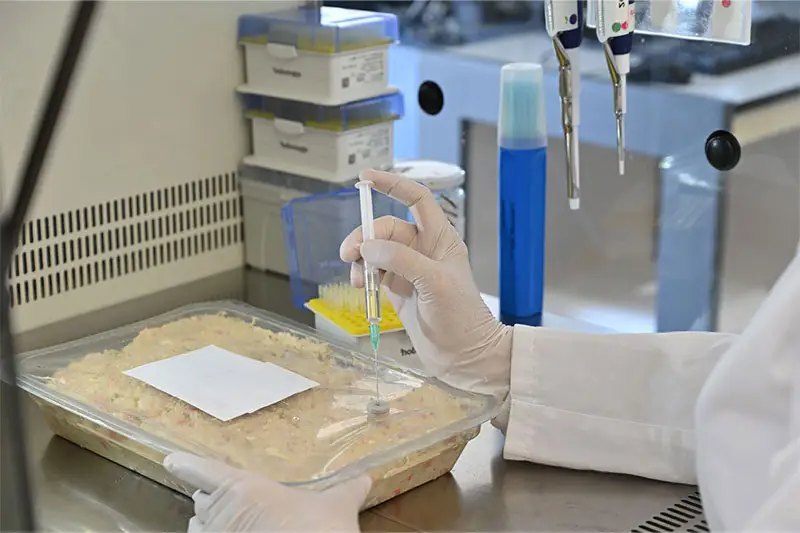Genomic Sequencing of Microorganisms in Cosmetics Testing
The advent of genomic sequencing technology has revolutionized microbiological safety testing within the cosmetics sector. This advanced analytical approach not only enhances the accuracy and reliability of testing but also provides deeper insights into microorganism behavior, identification, and potential contamination risks.
Genomic sequencing involves analyzing the DNA or RNA of microorganisms to identify their genetic makeup. In cosmetics testing, this method offers a more precise means of detecting harmful pathogens such as Listeria monocytogenes, Clostridium botulinum, and other opportunistic pathogens that can thrive in cosmetic formulations.
The process begins with the collection of samples from various stages of production, including raw materials, intermediates, and final products. These samples are then processed to extract genetic material, which is subjected to next-generation sequencing techniques. This allows for a comprehensive analysis of microbial communities present in cosmetics, providing information on both known and previously unidentified microorganisms.
One of the key advantages of genomic sequencing over traditional culture-based methods is its ability to detect low-level contamination that might be missed by less sensitive tests. Additionally, this technology enables the identification of antibiotic resistance genes, which can indicate potential health risks. By leveraging these insights, manufacturers can implement targeted interventions aimed at improving product safety and quality.
The application of genomic sequencing also facilitates compliance with international standards such as ISO 22716:2013, which mandates stringent hygiene practices in the cosmetics industry. It helps companies ensure that their products meet strict regulatory requirements for microbiological safety while maintaining a competitive edge in the market.
Moreover, this advanced testing technique supports ongoing research into novel antimicrobial agents and formulation strategies designed to prevent contamination effectively. As consumer demand for safer personal care products continues to grow, genomic sequencing plays an increasingly vital role in meeting these expectations by offering robust, science-backed solutions.
Why It Matters
Microbiological safety is paramount when it comes to cosmetics due to the intimate nature of contact between consumers and their products. Even trace amounts of harmful microorganisms can lead to severe health issues if not properly controlled during manufacturing processes. Genomic sequencing addresses these concerns by providing early detection capabilities, thereby minimizing risks associated with product recalls or litigation.
By implementing this cutting-edge technology, companies demonstrate their commitment to maintaining high standards of quality and safety across all aspects of cosmetic development and production. This proactive approach enhances brand reputation and builds trust among customers who value transparency about the ingredients used in their skincare and beauty routines.
- Enhanced Detection Capabilities: Traditional methods may overlook low-level contaminants; genomic sequencing ensures no stone is left unturned when it comes to identifying potential hazards.
- Improved Compliance: Meeting regulatory requirements like ISO 22716:2013 becomes easier with the support of advanced analytical tools such as genomic sequencing.
- Enhanced Consumer Trust: Demonstrating a dedication to safety through innovative testing practices fosters positive relationships between brands and their customer base.
In summary, adopting genomic sequencing for microbiological safety testing in cosmetics not only strengthens compliance efforts but also contributes significantly towards safeguarding public health while upholding industry integrity.
Competitive Advantage and Market Impact
The implementation of genomic sequencing technology offers several strategic benefits that can give organizations a significant competitive advantage. Firstly, it enables brands to stay ahead of emerging trends by continuously monitoring changes in microbial profiles within the cosmetic sector. Secondly, early detection allows for rapid response measures, reducing the likelihood of recalls and associated costs. Lastly, companies that embrace this advanced methodology position themselves as leaders in sustainable practices, appealing to environmentally conscious consumers.
| Competitive Advantage | Description |
|---|---|
| Enhanced Compliance | Ensures adherence to strict hygiene standards and regulatory frameworks. |
| Customer Trust | Bolsters reputation through transparent communication regarding product safety measures. |
| Innovation Leadership | Pioneers the use of state-of-the-art technologies in cosmetic manufacturing processes. |
Furthermore, genomic sequencing supports continuous improvement initiatives by providing data-driven insights into areas for enhancement. For instance, understanding how different ingredients interact with microorganisms can lead to more effective preservation systems and longer-lasting products. This capability translates directly into higher customer satisfaction levels and increased loyalty.
From a broader perspective, the adoption of such technologies contributes positively to societal well-being by promoting healthier living environments and supporting sustainable business practices. As consumer awareness continues to rise, companies that prioritize health and safety will find themselves better positioned to thrive in an increasingly competitive global market.
Use Cases and Application Examples
- Raw Material Screening: Genomic sequencing helps identify potential contaminants early in the supply chain, ensuring only safe materials enter production stages.
- Process Monitoring: Continuous monitoring allows manufacturers to track changes in microbial communities throughout various steps of manufacturing, facilitating timely adjustments if necessary.
- New Product Development: This technology aids in creating safer formulations by identifying likely sources of contamination before they become issues.
In a recent case study involving a major skincare company, genomic sequencing identified an unknown bacterial strain present in one batch of raw ingredients. Upon further investigation, it was determined that this microorganism could potentially pose risks if not properly managed during processing. As a result, the manufacturer adjusted their sterilization procedures accordingly, preventing any adverse effects on end users.
| Use Case | Description |
|---|---|
| Contamination Control: | Identifies specific contaminants responsible for spoilage or adverse reactions, enabling targeted mitigation strategies. |
| Quality Assurance: | Verifies the effectiveness of existing quality assurance protocols by validating results obtained through genomic sequencing. |
The ability to detect and eliminate contaminants at their source is crucial for maintaining consistent product quality. Genomic sequencing serves as a critical tool in achieving this goal, offering unparalleled precision and reliability compared to conventional methods.





